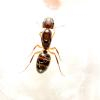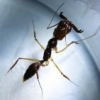1. Location of collection: Park.
2. Date of collection: 4/7/17
3. Habitat of collection: Rocky Hillside. Predominantly mixed Sweetgum, Buckeye, Oak and Eastern Hemlocks. Found beneath a rock with seven workers.
4. Length: 12 millimeters
5. Coloration, hue, pattern and texture: Black head and thorax. Orange-ish red abdomen with some light black horizontal striping. Legs orange-ish red. Still has wings. Visible mandibles
6. Distinguishing characteristics: relatively planar mandibles, face with hairs. Rather thin legs compared to overall size.
7. Anything else distinctive: When captured, workers immediately flocked to queen. Workers had slight variations in head size, didn't appear enough to be different castes.
8. Nest description: Found beneath a rock. Did not appear to be much of a nest, almost seemed like the group was just roving around.
9 . Post the clearest pictures possible of the top, side, and face of the ant in question, and if possible, their nest and the habitat they were collected in.
Sorry for the awful picture quality. I get a little nervous I'm going to lose my ants if I spend too long photographing.
























